Our Favorite Ground Cover Plants to Grow in Utah
Are you on the hunt for beneficial ground cover for your Utah yard? Well, you’ve come to the right place!
We’ve got a handful of plant species that are both gorgeous and beneficial. Ground covers can do wonders for any environment. Native ground cover may help you to attract beneficial insects and pollinators. Those same plants may help you to protect your soil, prevent erosion, suppress weeds, and conserve water. What follows are 18 ground covers that grow excellently in zones 4a through 9a. All of these plants are made to withstand the Beehive State’s dynamic weather!
Creeping Sedum (Phedimus spurius)
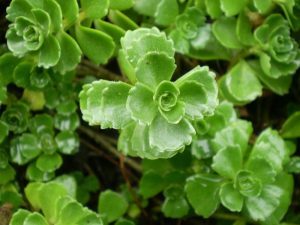
Creeping sedum is a popular North American ground cover. This hardy plant can take up root just about anywhere. The plant produces starlike clusters of small flowers and evergreen leaves. It typically grows to be 3 to 6 inches tall and 18 to 24 inches wide. It does not take long for a new plant to reach maturity.
Plant several sedum plants in one section to create a carpet-like cover. Add gravel to your soil to ensure that your plant’s roots do not get oversaturated with water. Keep in mind that sedum prefers full sun. Yet, it can tolerate partial shade.
Cooper’s Ice Plant (Delosperma cooperi)

Cooper’s ice plant is a low-lying succulent that originates from South Africa. This gorgeous cultivar produces a carpet of purple flowers and green foliage. The blossoms are daisy-like and have yellow centers. They typically appear throughout spring and summer.
The creeping plant does well in dry, sandy soil. It creeps along the ground, leaving large rocks and other structures exposed. Its low-lying structure makes it an excellent addition to tiered landscapes. Pair it with ornamental trees, perennials, and shrubs.
Hardy ice plant does not grow taller than 2 inches. However, it can measure up to 24 inches wide by the time it reaches maturity. These hardy perennials are not expected to live longer than half a decade. It thrives in zones 5 through 9.
This plant is available in a wide variety of colors, including purple, yellow, and orange.
Creeping Hummingbird Trumpet (Zauschneria latifolia)
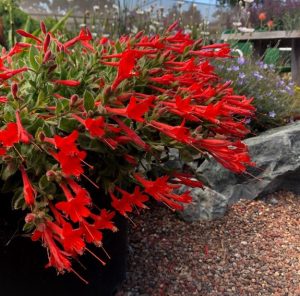
Creeping hummingbird trumpet is a low-lying perennial that’s native to the scrublands of the Southwest. The trumpet-shaped blossoms are available in bright orange and deep red. They grow in droopy clusters. They appear between July and September. The blossoms are accompanied by fuzzy leaves. Mature plants are usually between 4 to 6 inches tall and 15 to 18 inches wide. They tend to appear matted and dense.
This plant grows naturally in the Southwest. It thrives between Zone 5 and Zone 9. Its tubular flowers are beloved by native pollinators.
This dynamic cultivar does not require much maintenance. It can even withstand drought and erosion. Plant yours in a spot with well-draining soil. Don’t worry about amendments or fertilizer.
Utah Sedum
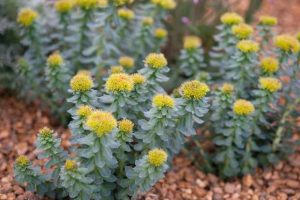
Utah sedum grows naturally in Utah. This hardy succulent can withstand some pretty harsh conditions. This particular variety of sedum has a carpet-like presentation. It produces small flowers and feathery leaves. The golden blooms appear in late summer.
Sedum is favored by butterflies. It can be propagated in a container or left to expand freely. Mature sedum plants measure between 2 to 4 inches tall and 12 to 14 inches wide.
These plants thrive in partial shade and full sun. They can be grown anywhere from zone three to zone nine. Alternative varieties include voodoo sedum, Turkish delight sedum, and reflexum sedum.
Scotch Moss (Sagina subulata)

Scotch moss is a fast-growing evergreen that spreads rapidly when it is propagated in ideal conditions. The plant produces clusters of flowers in early spring. The blooms are small, white, and lacey. They are accompanied by mat-like sections of mossy foliage. The mats tend to be dense and firm.
Scott moss plants are typically no taller than 2 inches. They can spread to be 8 to 10 inches wide. Plant yours in a spot with well-draining soil and full sun. Shade is likely to stunt this plant’s growth.
Hardy Yellow Ice Plant (Delosperma nubigenum)

Hardy yellow ice plant is a mat-forming evergreen that produces bright yellow flowers and succulent-like greenery. This plant grows particularly well in USDA Hardiness Zones 5 through 9. It does not demand much attention and expands rapidly.
Creeping Barberry (Berberis repens)

Creeping barberry is a woody groundcover that produces bright yellow flowers and dark blue berries. The plant typically grows no higher than 24 inches. While the plant’s blooms are fairly short-lived, its foliage sticks around all year.
Creeping barberry has more than one method of reproduction. This self-seeding, rhizomatous plant has no trouble spreading. However, it isn’t nearly as aggressive as other Utah ground cover varieties.
Plant yours in well-draining soil. Don’t fuss over particulars. This plant can thrive in just about any setting. Don’t bother to treat your barberry with pesticides or herbicides. The only things that creeping bayberry attracts are pollinators. Utah State’s Center for Water-Efficient Landscaping has even named creeping bayberry as one of the most efficient ground covers for Utah landscapes.
Flower Carpet White Rose

Flower carpet white rose is an ornamental ground cover that produces hot pink flowers with yellow centers. This showy plant blooms between late spring and early fall. The flowers sit alongside green foliage.
This impressive cultivar sits close to the ground. It requires very little maintenance. Use it as a yard alternative, border edging, ground cover, or container filler. This plant typically grows to be 3 feet tall and 3 feet wide. It thrives in Hardiness Zone 4a.
Snow-In-Summer (Cerastium tomentosa)
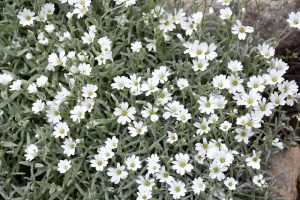
Snow-in-summer is a perennial plant that is native to Europe. It thrives in USDA Hardiness Zones 3 through 8. It’s a showy ground cover that thrives in direct sun and well-draining soil.
Popular varieties include silver carpet, yo yo, and columane.
White Sagebrush (Artemisia ludoviciana)

White sagebrush is an aromatic perennial that does well in Utah’s desert climate. The plant produces silvery-grey leaves. It can grow to be 1 1.2 to 3 feet tall. It spreads quickly and is capable of forming large colonies. The dense mats make excellent landscape borders.
Artemisia ludoviciana is native to North America. It can be found growing wild along the rocky prairies and bluffs of western North America and Mexico. It thrives in dry, semi-fertile soil.
Blue Leadwood (Ceratostigma plumbaginoides)
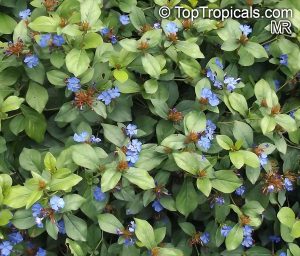
Plumbago, or blue leadwood, is a mat-forming perennial that is native to China. This plant thrives in USDA Plant Hardiness Zones 5 through 9. Despite its origins, it is not considered invasive.
Plumbago produces small clusters of deep purple flowers. Its leaves are shiny and green. Plumbago spreads by rhizomes. It can expand by 1 to 1 1/2 feet every year. It is considered a lucrative lawn replacement.
Mesa Verde Ice Plant

Mesa Verde, or kelaidis, is a blooming succulent that does well in USDA Zones 4 through 10. This plant produces a luscious canopy of gray-green foliage. The succulent-like leaves remain green all year long. The flowers are daisy-like. They have pinkish-purple petals and orange-yellow centers. They bloom between late spring and fall.
Mesa verde can be used as a ground cover or edge. Its showy flowers and long blooming season make it a popular garden amendment.
This lovely cultivar requires full sun and well-draining soil. It can be planted in containers, alongside walkways, and across lawns. This sort of ice plant can tolerate extreme heat and dryness.
Mature mesa verde ice plants are between 3 and 6 inches tall. This cultivar can spread 12 to 24 inches in a year.
Spotted Deadnettle (Lamium maculatum)
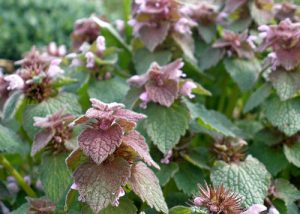
Spotted deadnettle is a fast-growing member of the mint family. This impressive herb does not grow to be taller than 9 inches. It spread quickly, forming thick mats. It has toothy leaves and purple flowers. It blooms in late spring and early summer.
There are several different colors and cultivars of spotted deadnettle. Popular varieties include Beedham’s wife, aureum, and Anne Greenaway.
Western Columbine (Aquilegia formosa)
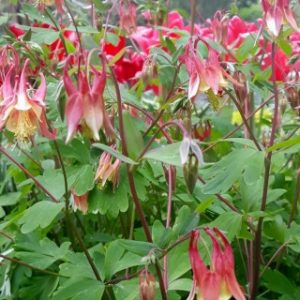
Western columbine, or crimson columbine, is a bushy groundcover that grows in the wild throughout western North America. It’s typically found along streams and in forests. It is easily propagated from seed. Mature columbine typically measures no taller than 18 inches. A single plant can be anywhere from 8 to 18 inches in diameter.
This enticing perennial features thickets of delicate leaves. The plant’s spurred flowers display a mix of colors, including red, yellow, and orange. They bloom between spring and late summer.
Western columbine is a favorite of native pollinators, including bees, butterflies, and moths. It’s also a known favorite of hawkmoths and long-tongue bees. Its seeds are safe for consumption. Who doesn’t love a ground cover that doubles as an edible crop?
Creeping Juniper (Juniperus horizontalis)
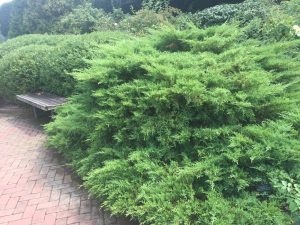
Creeping juniper is a fast-growing perennial that does particularly well in Utah gardens. The plant produces flowers and berries. However, the real stars of the show are the plant’s blue-green foliage.
Creeping juniper can expand to become a 10-foot carpet. It typically grows no higher than 1 1/2 feet. This lovely plant grows naturally in parts of the United States and Canada. It’s an excellent choice for gardens in USDA hardiness zones 3 through 9.
Angelina sedum (Sedum rupestre Angelina)

Angelina sedum is a mat-forming perennial that is native to western Europe. This evergreen plant does not usually grow taller than 4 inches. Mature plants typically measure between 12 and 24 inches wide. The plant produces succulent-like leaves and yellow blossoms.
Angelina sedum can tolerate Utah’s semi-arid to desert climate. Its matted structure keeps soil cool and prevents erosion.
Red Creeping Thyme (Thymus)

Creeping thyme is a hardy ground cover that grows everywhere from North America to Asia. Red Creeping time is a mat-forming perennial that produces purple flowers, hairy stems, and delicate foliage. The plant has a lovely aroma that is evoked by light foot traffic.
We love that this plant requires little to no watering. Its long-lasting blooms are welcome additions to any Utah garden. Creeping thyme takes a minimum of one year to reach full maturity. Once established, it grows rather slowly. Mature plants are usually just 1 to 2 inches tall and anywhere from 12 to 24 inches wide. Consider planting yours alongside stepping stones or pavers. This low-lying perennial makes an excellent gap filler!
Creeping Phlox (Phlox stolonifera)
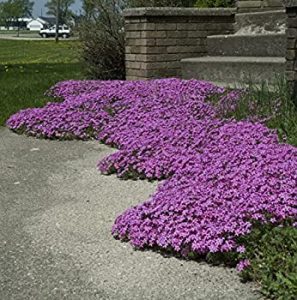
Creeping phlox, or pink ridge, is a low-lying perennial that produces an abundance of vibrant flowers. The fragrant blooms stem from 6-inch shoots. The delicate blooms typically appear between April and May. The blossoms are accompanied by evergreen leaves. This stunning plant thrives in moist, shady areas. This plant can be grown in USDA hardiness zones 3 through 9.
There are several colors and cultivars of creeping phlox. The most common varieties are pink, purple, and white. Most varieties form carpet-like clumps. These mounds measure anywhere from 10 inches to 2 feet in diameter. It takes most phlox plants at least two years to reach maturity. Once mature, this plant can grow up to 2 inches in a month.
We hope you enjoyed our rundown of the top ground cover plants for Utah gardens. These lovely plants require less maintenance and water than traditional lawns. Their blooms and foliage are welcome alternatives to run-of-the-mill grass. Most of them don’t even need to be trimmed. What’s not to love about a plant that’s both low-maintenance and incredibly attractive?


